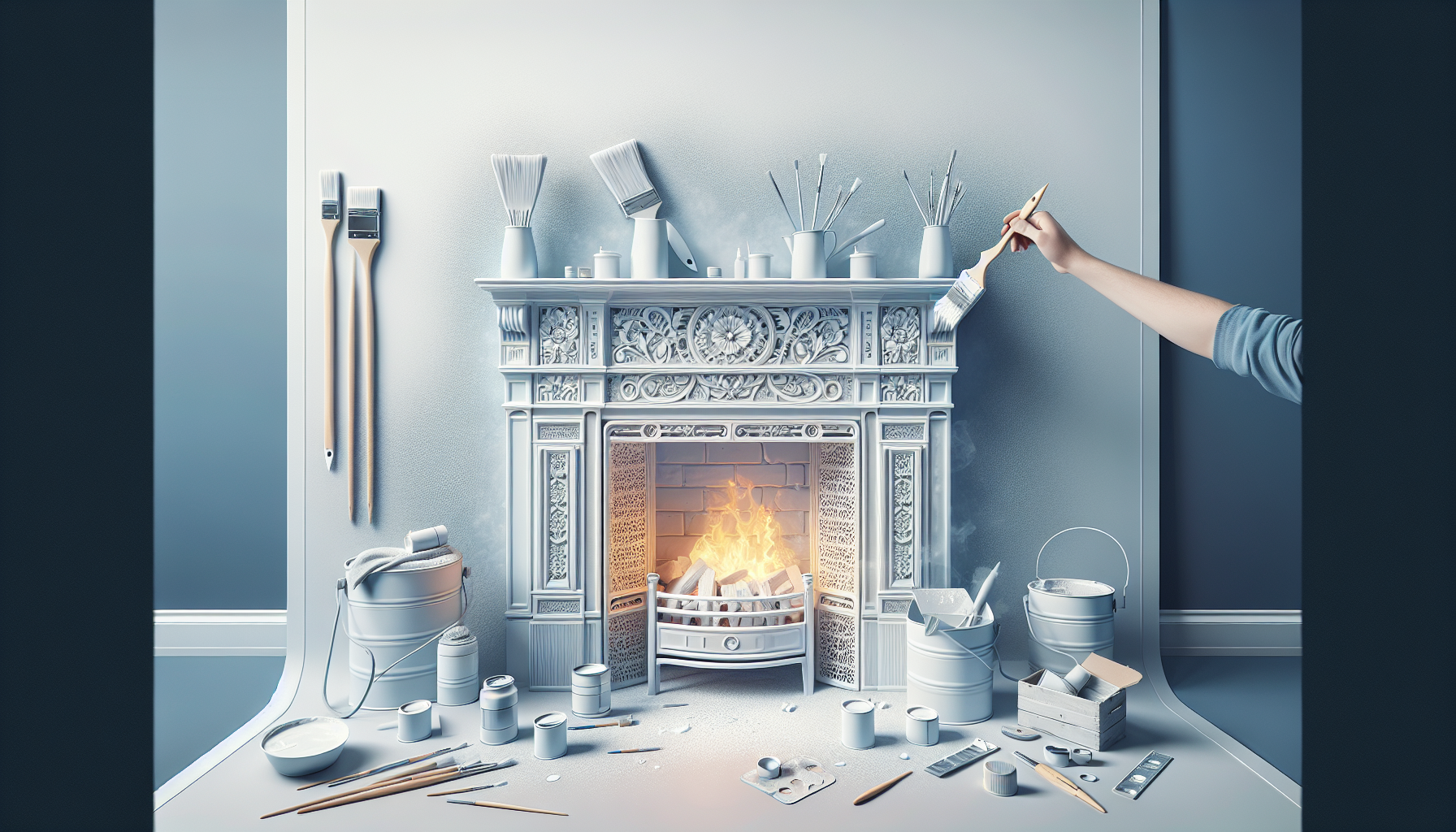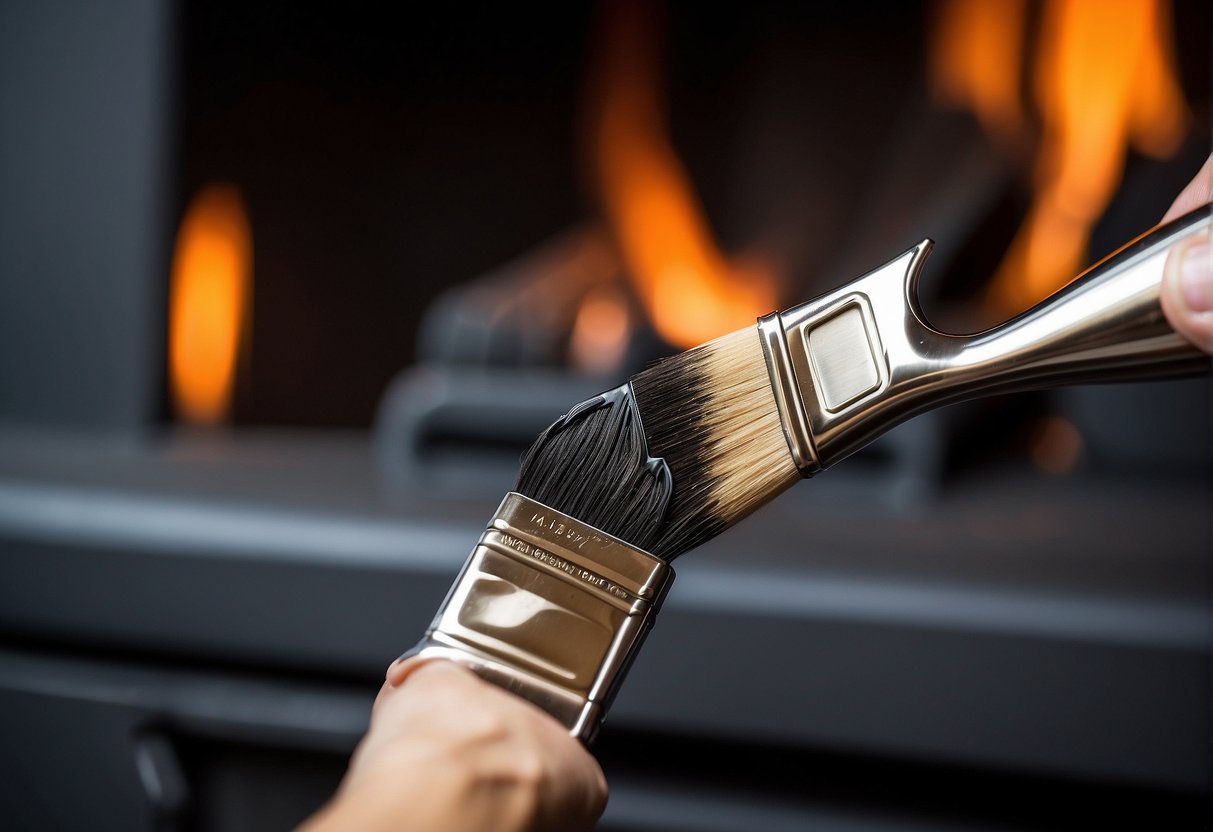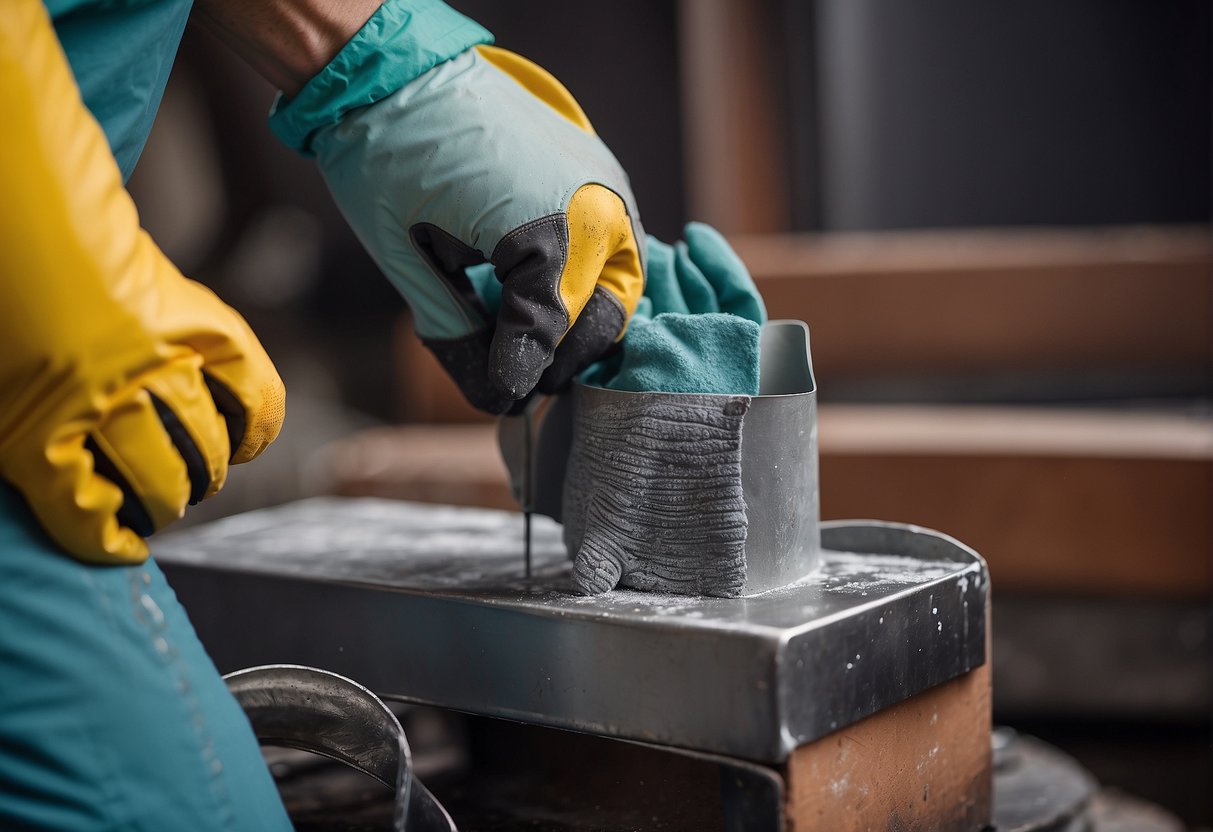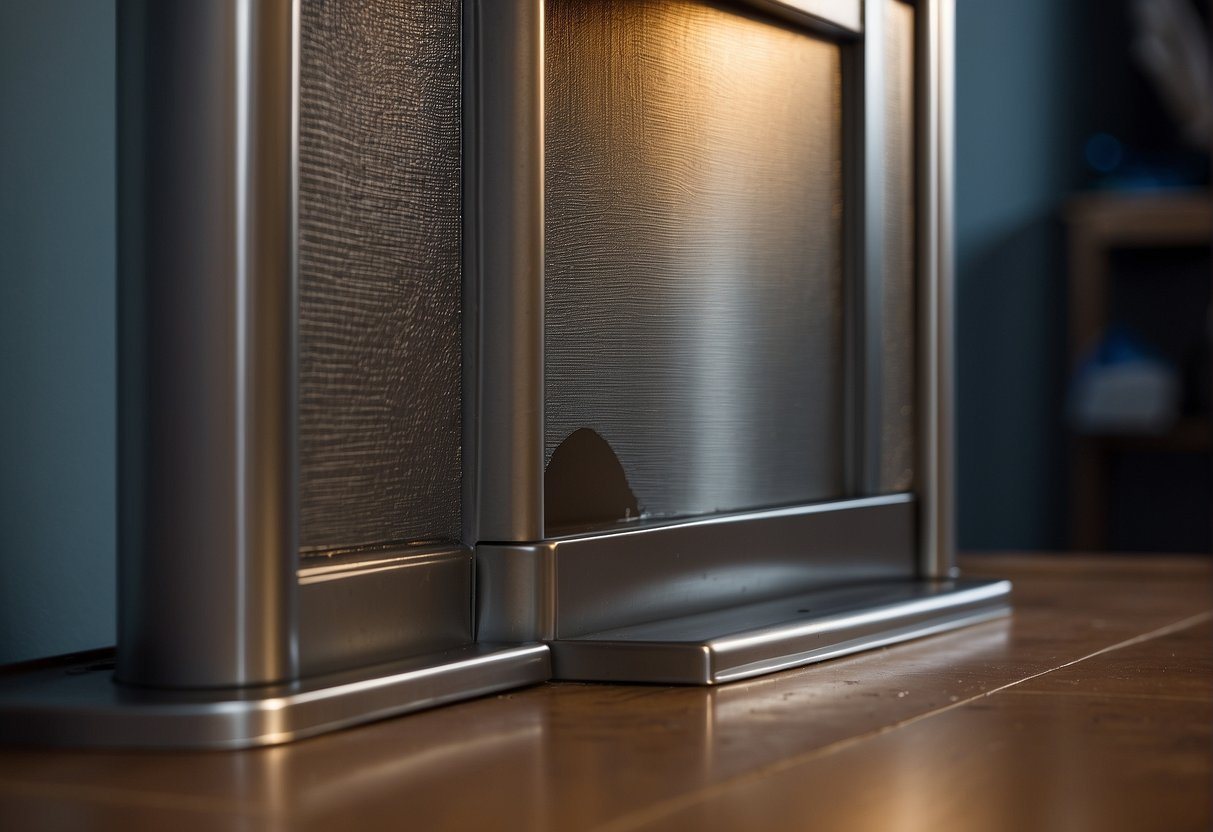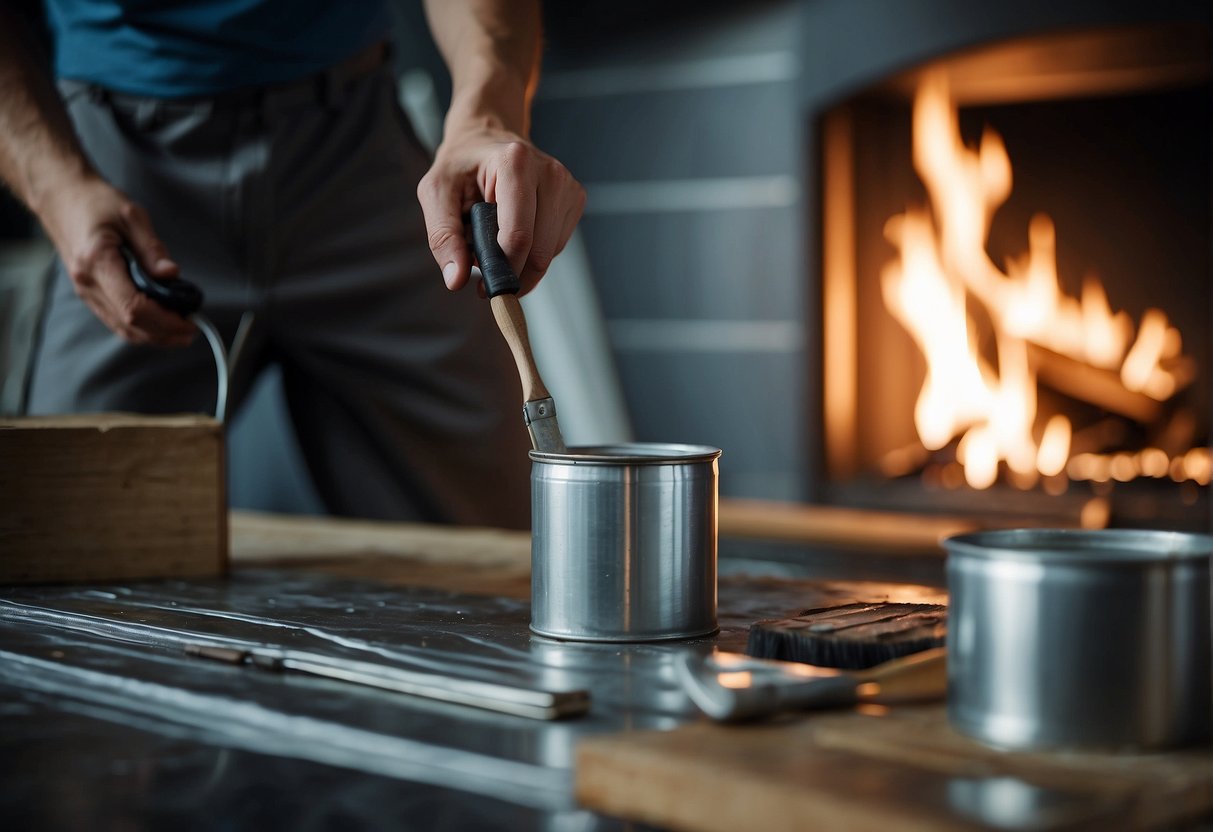Painting a metal fireplace can transform the look of your living space, imbuing it with a refreshed, modern aesthetic. This DIY project, though straightforward, requires attention to detail and a methodical approach to ensure a professional-looking finish. With the right tools and a clear process, anyone can breathe new life into an outdated fireplace. The key to success lies in meticulous preparation, application, and aftercare.
Before beginning your fireplace makeover, it’s essential to gather all necessary equipment and materials. Safety should be your top priority, so make sure to wear protective gear and work in a well-ventilated area. Thorough surface preparation is crucial; a clean, rust-free base will help the new paint adhere better and last longer. Equally important is the priming stage—choosing the correct primer for metal surfaces will provide a solid foundation for your chosen paint.
Key Takeaways
- Proper preparation of the fireplace surface is critical for paint adhesion.
- Correct priming sets the stage for a smooth and durable paint finish.
- Regular maintenance ensures long-lasting results and sustained aesthetics.
Preparation and Safety
Preparing to paint a metal fireplace requires attention to detail and a commitment to safety to ensure the best results. The process involves assessing the fireplace, gathering necessary materials, setting up a protected work area, and adhering to health and safety guidelines.
Assessing the Metal Fireplace
Before beginning your project, inspect the metal fireplace carefully for any signs of damage or rust. Use a wire brush to remove loose debris and rust flakes. If extensive rust is present, a more thorough scraping may be needed to create a smooth surface for painting.
Gathering Materials
For a successful painting job, you’ll need the following materials:
- Safety gear: gloves, goggles, and a mask
- Cleaning supplies: degreaser and rags
- Tools for prepping the surface: wire brush and sandpaper
- Painting supplies: metal primer, paint, and brushes
Ensure you have all items on hand before you start to prevent interruptions.
Setting Up the Work Area
Creating a safe and clean work area is critical to prevent damage to your surroundings. Lay out a drop cloth to catch any paint drips or debris. If you are painting indoors, make sure the space is well-ventilated. If possible, move the fireplace outside or open windows and use fans to circulate air.
Health and Safety Precautions
Safety precautions are necessary to protect yourself from harmful fumes and debris. Always wear protective gloves, eyewear, and a respiratory mask when sanding and painting. Read the labels on your degreaser, primer, and paint to be informed about any specific safety measures recommended by the manufacturer. Store all materials out of reach of children and pets, and dispose of any hazardous waste properly.
Surface Preparation
Prior to applying a new coat of paint, preparing the surface of a metal fireplace ensures adhesion and creates a more durable finish. This process involves a thorough cleaning, sanding, and repair of any surface damage.
Cleaning the Fireplace
Begin by removing any chipping paint, dirt, and debris from the metal surface. Cleaning is essential for the primer to adhere properly:
- Remove Loose Paint: Scrape away peeling or chipping paint using a paint scraper or wire brush.
- Dusting: Wipe the entire surface with a dry cloth to eliminate all dust.
- Degreasing: Apply a degreaser to remove any build-up of soot or grease.
Sanding the Surface
Once the surface is clean, sanding will create an ideal profile for the primer to bond:
- Coarse to Fine: Start with a coarse-grit sandpaper and finish with a finer grit for a smooth surface.
- Sand Evenly: Ensure all areas, including crevices, are evenly sanded.
Addressing Damages
Inspect for any cracks or crevices that may compromise the finish and address them:
- Fill Cracks: Use a high-temperature metal putty to fill in any cracks or damages.
- Smooth Repairs: After filling, sand the repaired areas until they blend seamlessly with the original surface.
- Primer Application: Once the surface is prepared, apply a heat-resistant metal primer to protect the fireplace and enhance paint adhesion.
Priming the Metal Fireplace
Before painting a metal fireplace, it’s essential to apply a proper primer. Primer serves as the foundational layer that ensures paint adhesion and longevity, especially important for surfaces exposed to high temperatures.
Choosing the Right Primer
High-Temperature Primer: A specific kind meant for surfaces that will be exposed to heat, such as metal fireplaces, is necessary. This type of primer can withstand the high temperatures a fireplace will reach without peeling or cracking.
Adhesion: It’s important to choose a primer that is formulated for nonporous, metal surfaces to ensure strong adhesion.
Application Technique
Applying Primer:
- Brushes and Rollers: Utilize high-quality paintbrushes or rollers designed for use with metal surfaces. Ensure they don’t leave behind lint or bristles.
- Thin Layers: Apply the primer in thin, even layers to avoid drips and ensure a smooth surface for painting.
- Drying Time: Allow adequate drying time as recommended by the primer’s manufacturer before applying the topcoat of paint.
Painting
Painting a metal fireplace requires careful selection of appropriate coatings that can withstand heat without deteriorating quickly. The coating must also adhere well to metal surfaces to ensure longevity and resistance to peeling or flaking.
Selecting High-Temperature Paint
High-temperature paint, specifically formulated to withstand intense heat, is essential for covering a metal fireplace. These paints are typically epoxy-based or silicone-based and can endure temperatures exceeding 500 degrees Fahrenheit. It’s important to thoroughly read product labels to confirm that the paint is suitable for metal surfaces exposed to high temperatures.
Spray Paint vs Brush-On Paint
When choosing paint type, there are two application methods to consider: spray paint and brush-on. Spray paint offers a uniform coat and can reach intricate areas without much difficulty. In contrast, brush-on paints allow for a thicker application and may require fewer coats. Both options should be of high-temperature grade, but spray paints often provide a smoother, streak-free finish.
Applying the Paint
To apply the paint, start with a clean, primed surface. If using spray paint, hold the can about 6 to 8 inches away from the surface, moving in steady, back-and-forth motions to avoid drips. For brush-on paints, use brushes designed for high-temperature applications, applying with deliberate, smooth strokes to minimize brush marks. Multiple thin coats are preferable to a single thick coat to ensure proper adhesion and drying.
Finishing Touches
After applying paint to the metal fireplace, the final installation of the mantel and surround, along with a detailed inspection, ensures a professional result. These finishing stages are critical for a cohesive appearance and long-lasting durability.
Attaching the Mantel and Surround
The mantel serves as a focal point and should be secured properly to complement the freshly painted metal fireplace surround. Begin by positioning the mantel above the fireplace, ensuring it is level before fixing it into place. Adherence to the manufacturer’s instructions for attachment is vital for safety and aesthetics. Once in place, apply painter’s tape to protect the mantel and surround’s edges from any additional painting or touch-up work.
Final Inspection and Touch-Ups
A thorough inspection of the metal fireplace surround is essential to ensure an even finish. Look for any missed spots, drips, or inconsistencies in the paint. Use a small artist’s brush to perform final touch-ups where needed. Carefully remove the painter’s tape to reveal clean lines between the mantel and the metal surround. Comparing the before and after appearance can highlight the transformation and help pinpoint any areas that might require a little extra attention.
Maintenance Tips
Maintaining a freshly painted metal fireplace is crucial to ensure that it continues to look its best for years to come. A well-kept fireplace can prevent prematurely worn paint and the necessity for extensive re-painting.
Regular Cleaning
Routine attention to your metal fireplace is integral in preserving its appearance. Use a soft cloth to gently wipe away any dust or debris. For more persistent dirt, a mild detergent mixed with water can be used, followed by a clean water rinse. It’s essential to avoid harsh chemicals or abrasive tools that could scratch or damage the paint surface.
Touch-Up Painting
Over time, the painted surface might sustain minor scuffs or scratches. When this happens, minor touch-up painting may be required. For the best results, ensure the area is clean and dry before applying paint. If the scuff is still visible after cleaning, apply a small amount of paint to the affected area with a fine-bristled brush. Multiple thin layers may be needed, allowing ample drying time between applications.
Design Considerations
When painting a metal fireplace, careful consideration of the design aspects ensures the end result complements the room’s aesthetic and meets your personal preferences.
Choosing a Color Scheme
White offers a classic and versatile option, particularly if your aim is to brighten the space and give a clean look that pairs well with a stone fireplace. However, it’s essential to consider the room’s existing color palette. Here are some points to remember while selecting colors:
- Complement Existing Decor: Choose colors that match your furniture and accessories for a cohesive look.
- Finish: Matte, satin, and gloss finishes can impact the visual feel of the room.
Consulting an Interior Designer
An interior designer can provide professional guidance tailored to your personal style and home’s layout. They can help you consider:
- Color Impact: Professional advice on how different colors can influence room dimensions and perception.
- Harmony with Structure: Recommendations on how to enhance the visual appeal of your metal fireplace in harmony with the home’s architectural features.
Each design element works in concert to create a desirable focal point that adheres to both your aesthetic desires and the practicalities of your living space.
Benefits of DIY Fireplace Painting
Enhancing your fireplace with a new coat of paint can be both satisfying and economical. The following subsections explain how you can save money and add a personal touch through a DIY approach.
Cost-Effectiveness
Painting your own fireplace is notably cost-effective compared to hiring professionals. By undertaking this DIY project, homeowners can save on labor costs which can be substantial. Typically, the only expenses involved are for the materials such as primer, paint, and basic painting supplies. Since fireplaces often require special heat-resistant paint, choosing to paint a fireplace yourself allows for better control over the budget by selecting materials based on cost without compromising on quality.
Creating a Personal Touch
A DIY project offers the opportunity to add a unique personal touch to your living space. By painting your fireplace independently, you can select the exact color and finish that complements your room’s decor. This hands-on approach allows for customization and the satisfaction of knowing that the end result is the product of your own vision and effort. Moreover, the process is not just quick and easy, but it also enables you to transform your fireplace into an attractive focal point that reflects your personal style.
Frequently Asked Questions
When repainting a metal fireplace, it’s essential to select the correct type of paint and follow specific steps for preparation and application to ensure a durable and heat-resistant finish.
What type of paint should be used for a metal fireplace surround?
For a metal fireplace surround, one should use high-heat-resistant paint. This is specifically formulated to withstand the temperatures a fireplace will generate.
What are the steps to painting a metal fireplace to achieve a black finish?
One would first clean the surface, then apply a metal-etching primer. After allowing the primer to dry, apply high-heat black paint in light, even coats to achieve the desired finish.
Are there special heat-resistant paints required for painting metal fireplaces?
Yes, painting a metal fireplace requires high-heat resistant paint that can endure the intense heat without peeling or blistering.
Is it safe to paint over a gas fireplace surround, and if so, how?
It is safe to paint a gas fireplace surround as long as one uses paint designed for high temperatures. The surface should be clean and properly prepped before painting.
How can one update or paint gold fireplace trim without damaging it?
To update or paint gold fireplace trim, lightly sand the trim to improve paint adhesion, then apply an appropriate high-heat primer followed by a high-heat resistant paint.
What is the best method for painting an iron fireplace to refresh its appearance?
The best method for painting an iron fireplace for a refreshed look involves cleaning the surface, removing rust if present, applying a rust-inhibiting primer, and finishing with a high-temperature paint suitable for iron surfaces.

